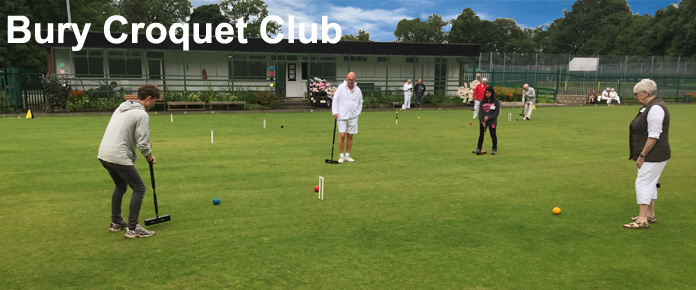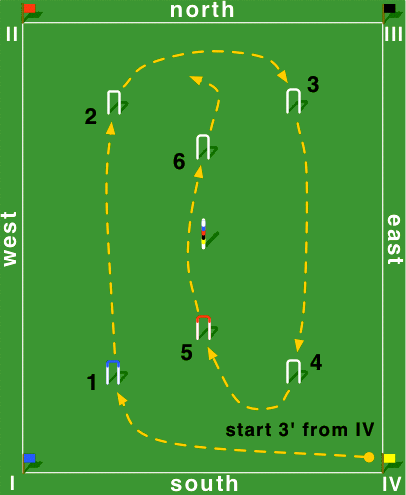

A hoop is won by the first ball to go through each hoop in a set sequence. There are no
additional turns for hitting other balls. Each player takes a stroke in turn, each trying to
hit a ball through the same hoop.
Golf croquet has a much simpler set of rules and therefore can be learned quickly.
Games are generally more interactive and take less time to complete. This makes the code attractive
to beginners who can use it to acquire some useful croquet skills.

The game is to break-play in a race around a circuit of hoops. Blue and Black balls play against Red and Yellow.
The first side to get both their balls through 12 hoops in order and hit the peg is the winner.
An Outline; Modern association croquet is played as a singles or doubles game in which two sides compete
against each other by hitting balls through a sequence of 12 hoops.
Hoops 1 to 6, followed by Hoops 2,1,4,3,6 & 5 or the Blue hoop is first and the Red hoop is the last. The ball then
hit the centre peg (peg-out) to win.
Golf Croquet,
Golf croquet has a long history, it has experienced a recent resurgence of interest at all levels.
There are now many golf croquet tournaments including regular world championships, so it is not just a
beginner's game.
The basics of the game In games of croquet the blue and black balls play against red and
yellow (if you are using secondary colours then it is green and brown, against pink and white).
Games can either be singles or doubles. If it is doubles then each of the two partners has one ball.
Beginning Starting from corner 4 everyone is for the same hoop (hoop 1 - the blue one), and
a point is scored for the side whose ball first runs the hoop in order. To run a hoop in order means to run it
in the correct direction. The normal hoop order and direction applies. The order and direction that hoops are
played are shown in the court diagram above.
Each person has only the one stroke in each turn. The balls are played in set colour sequence (blue, red, black,
and then yellow). This sequence is shown by the colours on the peg. (If two games are being played on the
same lawn then different coloured balls are used for the second game - in sequence green, pink, brown and white.)
Before the game there is a coin toss and the winner then plays blue 'the first ball' towards hoop one (H1),
followed by the other player(s) in the game. By the second turn it is usual to find players trying to get
right in front or even through the first hoop. As soon as one player makes that hoop, then all players
contest the next in order.
Careful If a player is unable to make a hoop, and sees that an opponent might do so,
there is a temptation to sneak towards the next hoop in order. There are penalties if they go more than half way
there!
Jawsed It is not necessary for a ball to go through a hoop in one shot. Sticking in the jaws
is okay until the next turn for that ball, BUT an opponent is allowed to knock the ball out. If the ball is
knocked through the hoop by an opponent, the opponent gives the first player the point.
Games lengths The standard version is played as best of 13 hoops, so that the first side to
7 hoops is the winner(H1-H6, then Hoops 2,1,4,3,6,& 5 in the other direction.
Guide to Golf Croquet Tactics A very simple introduction to the tactics of golf croquet. There
are skills in playing this version of the game and of particular importance is the ability to hit straight
either in order to make hoops or knock other balls away.
Given the objective is to get through a hoop before the opponent, two basic strategies used to achieve this
are;
1. Knock the opponent balls away.
2. Put your ball between the opponent's ball and the hoop or protect your other ball, if it is in a good
position by getting between it and and the next-to-play opponent's ball.
Jump shot - A useful shot when blocked is the jump, where, by hitting down on a ball, a player makes it
jump forwards - usually over an opponent's ball, or to make a difficult hoop (i.e. from a acute side angle).
When playing, it is important to remember the sequence of balls, and to plan how to protect your own balls
while frustrating your opponent. For example, you might wish to send a ball behind the hoop to be in a
position to knock the opponent's next ball out of, or away from, the hoop.
Laws Once the basics have been mastered, players must become familiar with the laws.
Fortunately there are only 16 of these. The rules concerning interference and faults require study and those
concerning behaviour and the respect for referees are different to what an Association Croquet player might expect.
If you are to enter a tournament, you must have an official handicap, and Law 16 sets out how to obtain this.
Finally the rules about playing for the next hoop must be understood.

Association Croquet,
An Outline - Association Croquet is played as a singles or doubles game in which two sides compete against
each other by hitting balls through a sequence of 12 hoops. In singles one player takes two balls and in any turn decides to play
whichever ball is better placed. In doubles, partners take one ball each but they must also decide which is the best
ball to play during a turn. By playing a sequence of strokes, players may keep a turn going (a break) and complete several
or all hoops in a single turn.
The game is won when two balls of one side complete all the hoops and "peg out", or if they
are ahead when time is called.
The art of the game is to master the physical side of using a mallet to hit balls very
accurately, and to be able to plan a winning strategy.
Scoring by making hoops - The balls are hit through six hoops in one direction (yellow line) and then
through the same six hoops but in a reverse direction. The final shot is to hit the peg in the middle of the lawn.
The side which "pegs out" both balls wins the game. Many games, though, are time limited. Then the side which scores
the most hoops wins.
Sequences of strokes - Players make a sequence of shots by hitting their ball on to another (a roquet). The
player then places their ball against the hit ball and plays a two-ball shot (a croquet shot) in order to get near another ball
or a hoop. They then play a further shot (a continuation stroke) to try and hit yet another ball or pass through a hoop.
Thus the sequence of shots is roquet, croquet and continuation.
Making breaks - In any one turn, a player may use any of the other three balls on the lawn once, in making
the sequence of shots before making a hoop. When a hoop is made, the three other balls may be used again. By using
a shot sequence, a player may move from one hoop to the next and thus make a whole series of hoops in the
one turn - called a break. Coloured clips placed on hoops are used to mark a player's progress.
Use of strategy - The game involves considerable strategy in placing balls in order to make breaks, and
skilled players can finish a game in a few turns. Many players do not achieve this level of skill, but can still
play successfully against more skilled players in handicap games where they can have extra turns (called bisques)
which reflect the differences in ability.
The game thus involves exercise, physical skill and the ability to develop a strategy for making breaks and winning games.
This is why it has be likened to a combination of chess and billiards played on lawns.
Some enjoy it for the social elements of club play, and others seek the competition. It is truly a game for all reasons.
